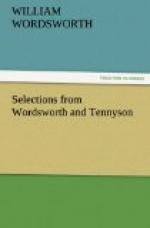195-196. AND HOLD—APRIL AUTUMNS. Objection has been taken to the somewhat pedantic precision of these lines. See, however, the reference on pp. lxxii.-lxxvii. to Tennyson’s employment of science in poetry.
The fact is familiar, of course, that in the Antipodes the seasons are the reverse of ours.
203. BRIONY RINGS. Formed by the tendrils of the plant.
IN MEMORIAM
The poem, In Memoriam, in memory of Arthur Henry Hallam, was published in 1850, at first anonymously, but the authorship was not long in doubt.
Arthur Henry Hallam, the son of Henry Hallam, the historian, was born in 1811. He entered Eton in 1822, and remained there until 1827, when he went to Cambridge. There he met Alfred Tennyson, and the two young men formed a friendship for one another, broken only by Hallam’s early death. In 1832, he graduated from Cambridge, became engaged to Emily Tennyson, the sister of Alfred, and entered on the study of law. In 1833, he had a severe illness and after his recovery was taken by his father for a tour on the Continent, in the hope of restoring his health. Sir Francis Hastings Doyle tells the story of his death: “A severe bout of influenza weakened him, and whilst he was travelling abroad for change of air, and to recover his strength, one of his usual attacks apparently returned upon him without warning, whilst he was still unfitted to resist it; so that when his poor father came back from a walk through the streets of Vienna, he was lying dead on the sofa where he had been left to take a short rest. Mr. Hallam sat down to write his letters, and it was only by slow and imperceptible degrees that a certain anxiety, in consequence of Arthur’s stillness and silence, dawned upon his mind; he drew near to ascertain why he had not moved nor spoken, and found that all was over.” The body was brought back to England and buried in Clevedon Church, on the banks of the Severn.
The effect upon Tennyson of the death of Arthur Hallam was overwhelming. For a time it “blotted out all joy from his life and made him long for death, in spite of his feeling that he was in some measure a help and comfort to his sister.” Under the influence of this great sorrow he wrote The Two Voices, Ulysses, “Break, Break, Break,” and began that exquisite series of lyric poems, afterwards joined together in the In Memoriam. His friendship for Hallam remained throughout life with him as one of his most precious possessions.
The poems in the text are selected from the In Memoriam, and have a more or less close connection with each other. It is better, however, to regard each poem as a separate poem, without any attempt to place it in its relation to the In Memoriam as a whole.
The best annotated edition of In Memoriam is that by A. C. Bradley (Macmillan). Other useful editions are edited by Wallace (Macmillan), and by Robinson (Cambridge Press). Elizabeth B. Chapman’s Companion to In Memoriam (Macmillan), contains the best analysis of the poem.




